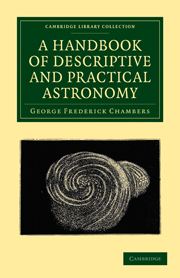Book contents
- Frontmatter
- PREFACE
- SUPPLEMENT
- Contents
- LIST OF ILLUSTRATIONS
- PRINCIPAL AUTHORITIES
- Errata
- A Handbook of Descriptive and Practical Astronomy
- BOOK I A SKETCH OF THE SOLAR SYSTEM
- BOOK II ECLIPSES AND THEIR ASSOCIATED PHENOMENA
- CHAPTER I GENERAL OUTLINES
- CHAPTER II ECLIPSES OF THE SUN
- CHAPTER III THE TOTAL ECLIPSE OF THE SUN OF JULY 28, 1851
- CHAPTER IV THE ANNULAR ECLIPSE OF THE SUN OF MARCH 14–15. 1858
- CHAPTER V THE TOTAL ECLIPSE OF THE SUN OF JULY 18, 1860
- CHAPTER VI HISTORICAL NOTICES
- CHAPTER VII ECLIPSES OF THE MOON
- CHAPTER VIII SUGGESTIONS FOR OBSERVING ANNULAR ECLIPSES OF THE SUN
- CHAPTER IX TRANSITS OF THE INFERIOR PLANETS
- BOOK III THE TIDES
- BOOK IV MISCELLANEOUS ASTRONOMICAL PHENOMENA
- BOOK V COMETS
- BOOK VI CHRONOLOGICAL ASTRONOMY
- BOOK VII THE STARRY HEAVENS
- CHAPTER I
- Chapter II DOUBLE STARS, ETC.
- CHAPTER III
- CHAPTER IV CLUSTERS AND NEBULÆ
- CHAPTER V THE MILKY WAY
- CHAPTER VI THE CONSTELLATIONS
- BOOK VIII ASTRONOMICAL INSTRUMENTS
- BOOK IX A SKETCH OF THE HISTORY OF ASTRONOMY
- BOOK X METEORIC ASTRONOMY
- APPENDICES
- INDEX TO SUBJECTS
- INDEX TO NAMES
- Plate section
CHAPTER IV - CLUSTERS AND NEBULÆ
Published online by Cambridge University Press: 05 July 2011
- Frontmatter
- PREFACE
- SUPPLEMENT
- Contents
- LIST OF ILLUSTRATIONS
- PRINCIPAL AUTHORITIES
- Errata
- A Handbook of Descriptive and Practical Astronomy
- BOOK I A SKETCH OF THE SOLAR SYSTEM
- BOOK II ECLIPSES AND THEIR ASSOCIATED PHENOMENA
- CHAPTER I GENERAL OUTLINES
- CHAPTER II ECLIPSES OF THE SUN
- CHAPTER III THE TOTAL ECLIPSE OF THE SUN OF JULY 28, 1851
- CHAPTER IV THE ANNULAR ECLIPSE OF THE SUN OF MARCH 14–15. 1858
- CHAPTER V THE TOTAL ECLIPSE OF THE SUN OF JULY 18, 1860
- CHAPTER VI HISTORICAL NOTICES
- CHAPTER VII ECLIPSES OF THE MOON
- CHAPTER VIII SUGGESTIONS FOR OBSERVING ANNULAR ECLIPSES OF THE SUN
- CHAPTER IX TRANSITS OF THE INFERIOR PLANETS
- BOOK III THE TIDES
- BOOK IV MISCELLANEOUS ASTRONOMICAL PHENOMENA
- BOOK V COMETS
- BOOK VI CHRONOLOGICAL ASTRONOMY
- BOOK VII THE STARRY HEAVENS
- CHAPTER I
- Chapter II DOUBLE STARS, ETC.
- CHAPTER III
- CHAPTER IV CLUSTERS AND NEBULÆ
- CHAPTER V THE MILKY WAY
- CHAPTER VI THE CONSTELLATIONS
- BOOK VIII ASTRONOMICAL INSTRUMENTS
- BOOK IX A SKETCH OF THE HISTORY OF ASTRONOMY
- BOOK X METEORIC ASTRONOMY
- APPENDICES
- INDEX TO SUBJECTS
- INDEX TO NAMES
- Plate section
Summary
On examining the heavens on a clear evening, when the Moon is not shining, we find here and there groups of stars which seem to be compressed together in such a manner as to present a dull cloud-like appearance: these are termed clusters and nebulæ, and are usually classed as follows: —
Irregular groups, visible more or less to the naked eye.
Clusters resolvable into separate stars with the aid of a telescope.
Nebulæ, for the most part irresolvable.
The latter are subdivided into: —
i. Annular Nebulæ.
ii. Elliptic Nebulæ.
iii. Spiral Nebulæ.
iv. Planetary Nebulæ.
v. Nebulous Stars.
Of the 1st class, there are several examples to be found, with all of which the reader is probably more or less familiar. The cluster of the Pleiades in Taurus is probably best known. When examined directly, few persons can see more than 6 stars, but by turning the eye sideways, we discover there are many more, and between 50 and 60 are visible in a telescope. The most brilliant star in the group is Alcyone, or η Tauri, of the 3rd magnitude ; next in order come Electra and Atlas of the 4th; Maia and Taygeta of the 5th; Pleione and Celeno, which are between the 6th and 7th; Asterope between the 7th and 8th; and finally, a great number of smaller stars.
- Type
- Chapter
- Information
- A Handbook of Descriptive and Practical Astronomy , pp. 294 - 301Publisher: Cambridge University PressPrint publication year: 2010First published in: 1861



